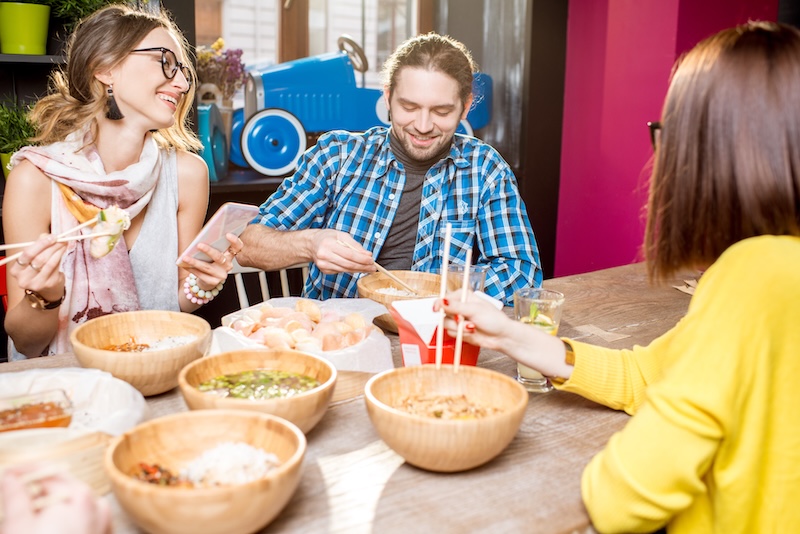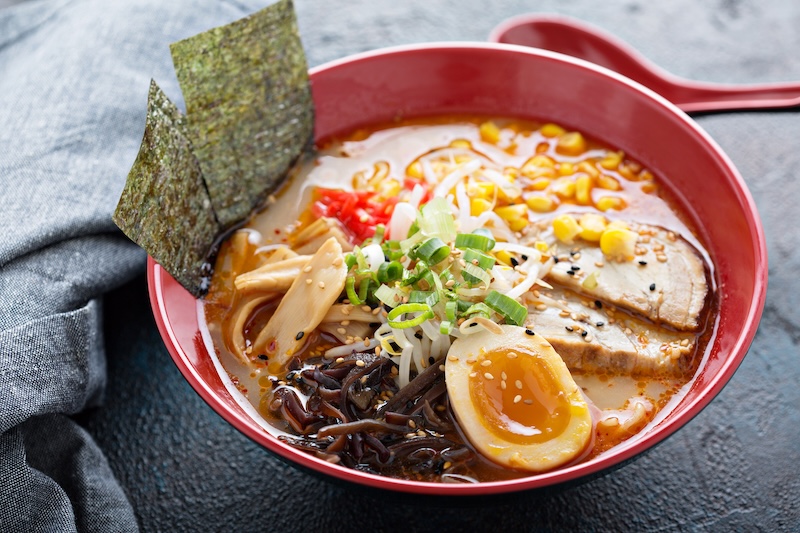Ramen, that generous, comforting Japanese dish, has become a permanent fixture in French eating habits. In major cities, it's not uncommon to see queues outside ramen bars at lunchtime. This steaming bowl of noodles and broth appeals for its affordability, authenticity and conviviality.
So, if you're a restaurateur and the idea of launching your own ramen concept appeals to you, you should know that the potential is enormous. But beware: opening a ramen restaurant isn't something you can improvise. From concept and budget to organization, regulations and customer loyalty, we've put together a practical guide to help you build a solid, profitable project.
Study the market and define your concept
Why ramen is so popular in fast food
The ramen's success is based on three major assets:
- Comforting cuisine: a long simmered broth, soft noodles, generous fillings,
- Affordable prices: between €12 and €18 on average, perfect for a quick lunch,
- A strong identity: the ramen immediately transports customers to the Land of the Rising Sun.
Ramen restaurants have everything it takes to attract a varied clientele: from students to busy working people, as well as lovers of authentic cuisine.
Choose your positioning: authentic, fusion or street food
To stand out from the crowd, take the time to define your identity right from the start:
- Authentic: traditional broths (shoyu, miso, shio, tonkotsu), recipes faithful to Japanese tradition,
- Fusion: mixing influences (duck ramen, French-style vegetarian ramen),
- Street food: fast concept, affordable prices, service designed for the lunch break.
A customer needs to understand your proposition and positioning at first glance.
Set the average price of a bowl of ramen in France
Today, most ramen is sold for between €12 and €18. For a restaurateur, this is an attractive average ticket, especially if you offer high-margin extras such as gyozas, matcha desserts or Japanese drinks.
Build a short, profitable card
Avoid the classic mistake of a menu that's too long. A signature ramen + 3 or 4 variations are enough. You'll gain in consistency, quality and operational efficiency. And don't forget to include one or two seasonal options or monthly specials to surprise your customers and keep them coming back for more.
Budgeting and financing
Cost of premises, equipment and raw materials
Before opening your ramen restaurant, keep in mind the main expenses you'll need to cover:
- The premises and their layout: choose a high-traffic area (student neighbourhoods, offices, city centers);
- Equipment: large cooking pots, powerful stoves, noodle machine, high-performance air extractor ;
- Raw materials: meats, vegetables, sauces, fresh noodles. The quality of ingredients is a key factor.

Overall opening budget and financing solutions
In France, the budget to open a small ramen restaurant ranges from €80,000 to €150,000, depending on size, location and level of equipment.
What financing solutions are available?
- Personal contribution: often mandatory to obtain a loan, it generally represents 20 to 30% of the total budget and shows your commitment to financial partners.
- Bank loans: classic but effective, especially if your personal contribution is solid and your business plan convincing.
- Private investors: business angels or specialized restaurant networks, who can provide funds and expertise.
- Regional and sector-specific assistance: subsidies, interest-free loans, business start-up schemes in the catering sector.
- Crowdfunding: increasingly used to test the concept while mobilizing a community of future customers.
👉 To find out more : Creating a restaurant: how to finance your project?
Calculating margins and controlling food costs
A bowl of ramen costs an average of €3 to €4 in raw materials. With a selling price of around €14, you can quickly do the math. Margins are attractive, but beware of losses, poorly controlled purchases and wastage, which can quickly eat away at your profitability.
Another valuable tip: keep a close eye on your food cost. Also known as the "raw materials cost/ratio", this is what determines the viability of your project. It represents the portion of the selling price of a dish that corresponds to the cost of the ingredients used to prepare it. In other words, it's how much each portion you serve actually costs you.
In the restaurant business, a food cost of between 25 and 35% is generally considered reasonable for a profitable dish. Good management of this indicator will enable you to invest in the quality of ingredients and improve the customer experience.
Menu ramen profitability and pricing strategies
A ramen is a dish that is eaten relatively quickly, which works in your favor, as it translates into better table rotation and therefore more volume.
To increase your margins, you can offer :
- Attractive extras: gyozas or karaage starters, original Japanese desserts, imported drinks (ramune, iced teas, sake).
- Value-added combination menus: for example, a "lunch menu" with ramen + small drink + dessert at a slightly reduced price, which encourages a higher average basket.
- Customizable premium options: offer special toppings (truffles, marinated organic eggs, quality braised pork) to be added to the bowl, increasing margins without a lot of extra work.
- Limited or seasonal offers: a ramen of the month with seasonal ingredients or a special recipe that creates a sense of exclusivity and encourages return visits.
- Additional in-store and take-away sales: homemade sauces, fresh noodles to take away, ramen kits for cooking at home.
Set up your operational organization
Training and recruitment: finding or training a ramen chef
You can tell a good ramen by the quality of its broth. To guarantee it, recruiting an experienced chef is a major asset, but it's also possible to train your team through specialized workshops or courses, to spread this know-how within your restaurant. "
Team organization and fast service
Ramen is a popular dish that can make service particularly intense, especially at lunchtime. To ensure that everything runs smoothly, several points are essential:
- A visible counter where customers can see what's being prepared,
- Clear organization between kitchen and dining room,
- A modern checkout system for on-site, takeaway and delivery orders.
👉 To find out more: Opening a restaurant: 13 mistakes not to make
Suppliers and selection of key ingredients
Choosing the right partners is crucial. For example, working with a local artisan for noodles can be a real differentiator. Also remember to select reliable suppliers for broth, meat and garnishes to ensure consistent quality.
Finally, establishing a lasting relationship of trust with your partners often enables you to negotiate better rates and deliveries adapted to your volumes, which reduces waste and secures your margins.
Specific equipment: machines, cooking pots, ramen kitchen
When equipping your restaurant, bear in mind that your equipment needs to be designed for high volumes: large capacity kettles, powerful stoves, air extractors, and possibly a noodle machine if you produce them in-house.
And don't forget to provide adequate storage space for fresh and dry ingredients, to optimize day-to-day logistics. Finally, investing in reliable, easy-to-maintain equipment will save you time and limit the risk of costly downtime.

Comply with regulations and secure your project
Respecting the rules and securing your project are essential to avoid unpleasant surprises and guarantee the long-term future of your restaurant. As with any establishment, compliance with hygiene standards and legal obligations is mandatory: food traceability, cold storage, temperature control, regular cleaning and HACCP monitoring.
In terms of licensing and administrative compliance, you must :
- Obtain the necessary liquor license if you offer Japanese beer or sake;
- Clearly display prices, allergens and meat origin to comply with legislation.
The choice between franchising and independence also has an impact on your project:
- Franchise: you benefit from a turnkey concept and support, but you lose some of your creative freedom;
- Independent: you retain total freedom over your concept, but the risks and responsibilities are higher.
👉 To find out more: What legal form should you choose to set up your own restaurant?
Attracting and retaining customers
Building a strong brand identity
An evocative name, a simple logo and a clear story around your concept all help to create an emotional bond with your customers and set you apart from the competition. Don't hesitate to integrate your Japanese universe into all your media, from cards to social networks, to reinforce your image.
Customer experience and immersion around Japan
A few touches are all it takes to transport your customers: a Japanese counter, wood decor, lanterns, sound ambiance. Think too of subtle details such as tableware, napkins or bowl presentation toturn every visit into a little Japanese getaway.
Digital marketing and local communications
To attract and retain customers, it's essential to take care of your online presence and local communications. But what digital actions should you prioritize to maximize your visibility and guest engagement with your establishment? :
- A well-informed Google Business Profile to be easily found and well referenced,
- An Instagram account with photos of mouth-watering bowls to whet the appetite and create engagement,
- Partnerships with local food influencers to reach new audiences,
- One-off campaigns, such as special promotions or themed events, to attract new customers and generate word-of-mouth.
Surround yourself with tools and partners to grow
Running a ramen restaurant involves demanding day-to-day management. For greater efficiency, you can rely on high-performance cash register software, real-time inventory tracking and reliable logistics partners to help you develop your business without stress. Outsourcing certain tasks, such as accounting or digital marketing, can also free up your time to focus on the quality of your food and service. Last but not least, working with responsive suppliers ensures that you never run out of essential ingredients, and avoids any stock-outs that could lead to customer frustration.
Opening a ramen restaurant in 2026 is an adventure where creativity, rigor and a sense of service come together. The market is as buoyant as the competition is fierce: from the quality of the broth to the customer experience, nothing must be left to chance. By refining your concept, controlling your costs and offering an immersive journey around Japan, you have all the keys to making your establishment a must-visit address.
-
Are you looking for digital solutions that are truly adapted to your ramen restaurant? Innovorder offers an all-in-one solution, designed to meet your challenges in the field and capable of evolving with your business.






.png)
